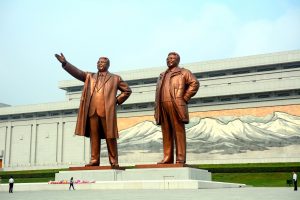Torture, famine, infanticide, thought control, isolation, gulags, lack of medicine, and trafficking in chemical and nuclear weapons are all things we associate with the Democratic People’s Republic of Korea, more commonly known as North Korea. Currently, the United States is locked in escalating negotiations with North Korea that have evolved into threats of nuclear war. Given the regime’s repressive nature and poor economy, how has the Kim family maintained its iron grip on North Korea for 72 years? Why have they not been overthrown? Let’s look at the history.
The history of North Korea is aligned with the history of the Kim family. Kim Il Sung, Kim Jung Il and now Kim Jung Un have been the only rulers of North Korea. Kim Il Sung was ruler for the longest period of time, from 1945 to 1994. His rise was unlikely as he grew up in China after his Christian family fled Japanese occupied Korea in 1920 when Kim was a boy. He grew up in a largely Korean area of China and converted to communism as a teenager. Eventually, he joined anti-Japanese guerrilla groups and participated in several skirmishes against the Japanese. By the outbreak of World War II, Kim Il Sung had been successful enough as a guerrilla to be known to Japanese, Chinese and Russian party officials. He found safe harbor during the war in the Soviet Union.
After WWII, at age 33, the Soviets returned Kim Il Sung to North Korea to put a Korean face on Soviet control of the country. Once in power, Kim Il Sung cultivated relations with the Soviet Union, China and other communist countries while he also consolidated internal power by eliminating rivals, erasing religion and changing history books. To this day North Koreans are taught that Kim Il Sung started the Korean Peoples Army, that he was not put into power by the Soviets, and that South Korea started the Korean War.
Kim Il Sung also kept power by instituting the policy of juche which means independence from the world. North Koreans are told they are a pure race and therefore must rely on each other and keep themselves separate from the rest of the world. It weaves in the strict hierarchy of Confucianism so that the leader is at the top with a strict structure going all the way down to “hostiles” at the bottom. He directed the masses be taught that obedience of the people to this hierarchy is needed to ensure racial purity.
Kim Jung Il was born in 1942 while his family was in exile in the Soviet Union. He returned with his family to North Korea when his father came to power. He spent the Korean War in China. He did not possess the revolutionary background of his father. He tried to legitimize following his Dad to power by involving himself in limited terrorist activities of the north, being the most supportive proponent of Kim Il Sung’s cult of personality and going after anyone perceived as disloyal. He built more statues of his father than any of his rivals for power and was rewarded by being names Kim Il Sung’s successor 20 years before his father’s death.
Despite personal excesses such as prostitutes, alcohol, drugs and gluttony, Kim Jung Il was able to hold on to power and pass control of North Korea on to his son. He was able to do this by adding the idea of kimilsungism to juche. Kimilsungism built on the ideas of the necessity of racial purity and independence enforced by a strong and loving leader to say that Kim Sung Il (and by extension members of his family) was the leader needed to look out for the Korean people. Kim Jung Il also secured his power by keeping control of the military and maintaining good relations with the Soviets and the Chinese.
Kim Jung Il died at the young age of 70, probably due to his life style of excess. He passed control of the country on to his son, Kim Jung Un. Not much is known about Kim Jung Un. He most likely spent several years at a school in Switzerland in his youth. Most of his classmates found him to be shy and he hid who his parents were. The youngest Kim is now in the process of solidifying his control of North Korea by cultivating relations with the military and the Chinese, building nuclear capabilities, keeping the North Korean people isolated and eliminating critics and possible rivals such as his uncle and half-brother. So far he has succeeded.
So, despite the misery they have produced, how is the Kim family still in power in North Korea? Juche and kimilsungism combined with tyranny maintain internal control. Additionally, those around the Kim family are elites at the higher end of the social strata who know they will lose everything and may even be killed if the regime falls. Therefore, the incentive or ability to overthrow the Kim family is low. Finally, support from the outside, first from the Soviets and currently from the Chinese, enables the Kim dynasty to continue.

